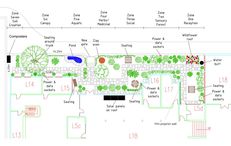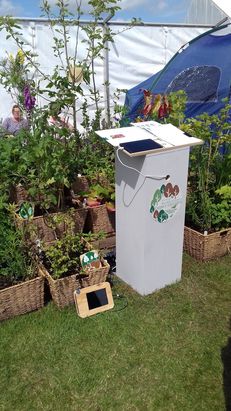Academic researcher Callum Egan, working in the field of human-computer interaction, is developing permaculture-inspired sustainability gardens at Edinburgh Napier University’s Merchiston campus. Interaction with the garden will be augmented with digital experiences, linking the campus’ green spaces with IT in creative and innovative ways.
Living Labs
The garden is being developed as a living labs project with input from staff and students, alongside academic research, and is also informed through work with the wider community. Planning the garden as a living labs project means it will fulfil an array of diverse needs for all possible users of the garden. The garden is still in development and exact details are not formalised, though is likely to feature some form of augmented reality incorporating education for sustainable development, which may link to or complement learning from students’ academic modules.
An example given in plans for the garden is viewing plants through a smartphone camera, with the image linking to videos, images, text, etc., providing insights into sustainability and development projects elsewhere in the world, and interpretation of sustainable garden elements. Linking education for sustainable development with green spaces will expand engagement on issues around wellbeing, climate change, food, and other issues.
Holistic Approach
While interactions with the garden are linked to technology, the garden design takes a holistic approach to sustainability, incorporating medicinal plants, sensory and wellbeing areas, using water to reduce noise from traffic, and ensuring the garden is accessible to all. There are also plans to incorporate sustainability focussed art works, and experiences that are dependent on environmental conditions; for example, triggered by rain, shadow, sun, different temperatures.
The interim design for the garden includes power and data sockets, with Wi-Fi enabled, so students and staff can work and socialise in the space. There are also plans for solar panels, raised beds, composters, and a greenhouse, supporting Edinburgh Napier’s sustainability from many perspectives at once.
Staff and Student Engagement
The garden’s development has included idea input from academics and students, as well as practical input from professional department staff, including Edinburgh Napier’s IT department. The collaborative approach to design ensures a broad range of people feel ownership of the garden, increasing the likelihood that it will accommodate a range of people, which has the potential to foster closer community links inside and outside of the university.
Through technology, the garden is likely to engage a new audience with green spaces on campus, promoting wellbeing and educating students and staff in environmental and sustainability topics. The overlap between academic research on IT (human-computer interaction) and behaviour change, usually the priority of Sustainability teams, is a novel one that may prove effective in the coming years.
Current Work
At present the garden is undergoing LAND certification by the Permaculture Association, instituting it as a learner and demonstration site. The project is supported by the Edinburgh Napier Estates department, and the School of Computing and currently has around 15 people involved with it. These include researchers, Estates staff, catering staff, Information Systems staff, MSc and undergraduate students, contractors, the Permaculture Association, local craftspeople, professors and administrators. We are in the process of drawing-up volunteer policies and once these are in place we will be advertising for support from intra and extra university volunteers.
Plans for the Future
The project is still in its infancy, though land has been cleared, a poly tunnel erected, tools bought, pathways marked, compost delivered. Over the coming months considerable activity is planned. We have employed a horticulturist to kick-start growing and run courses in subjects such as composting, growing, harvesting, preserving etc. Later in the year we’re constructing a small green building via a co-build method. There are plans for a covered reception area, staging for live performance, ponds, water-harvesting, green roofs, rooftop kitchen allotment, food forests and an orchard. Students are working on designs, web applications and local WI-FI networks.
For more information and to get involved please contact Callum Egan.
If you are looking to engage with your Catering Department read the 'Engaging Professional Departments' Guides here. Or contact the EAUC-Scotland Team for further training, facilitated workshops or meetings.









 Except where otherwise stated, content on this site is
licensed under a Creative Commons Attribution 3.0 License.
Except where otherwise stated, content on this site is
licensed under a Creative Commons Attribution 3.0 License.
